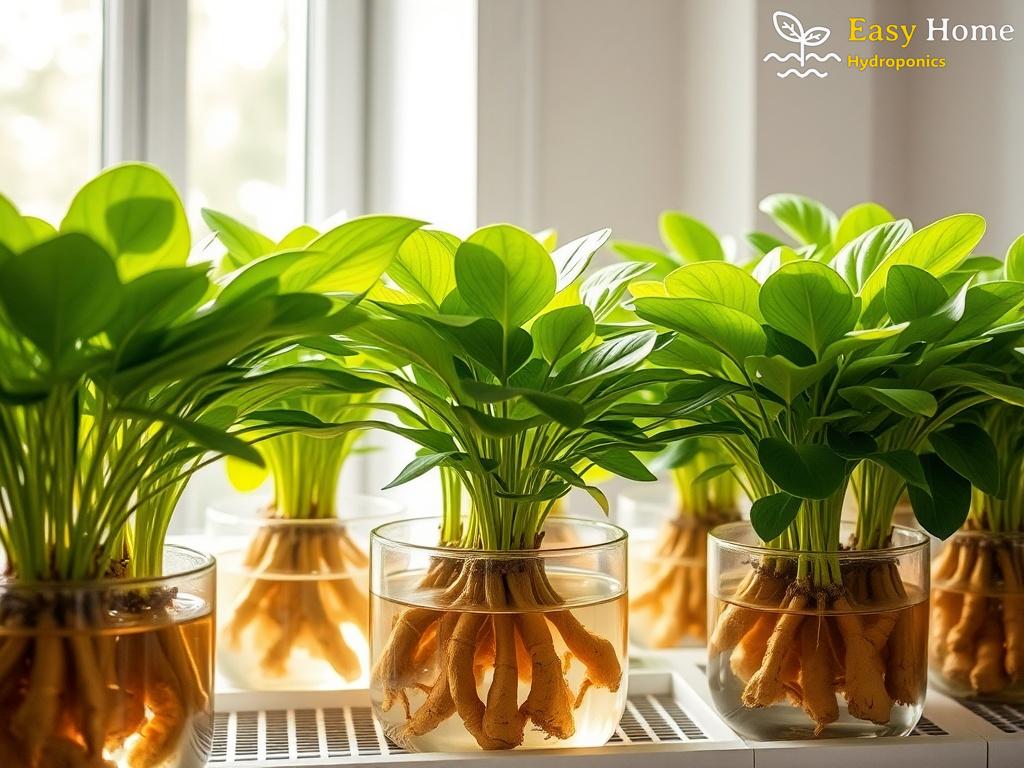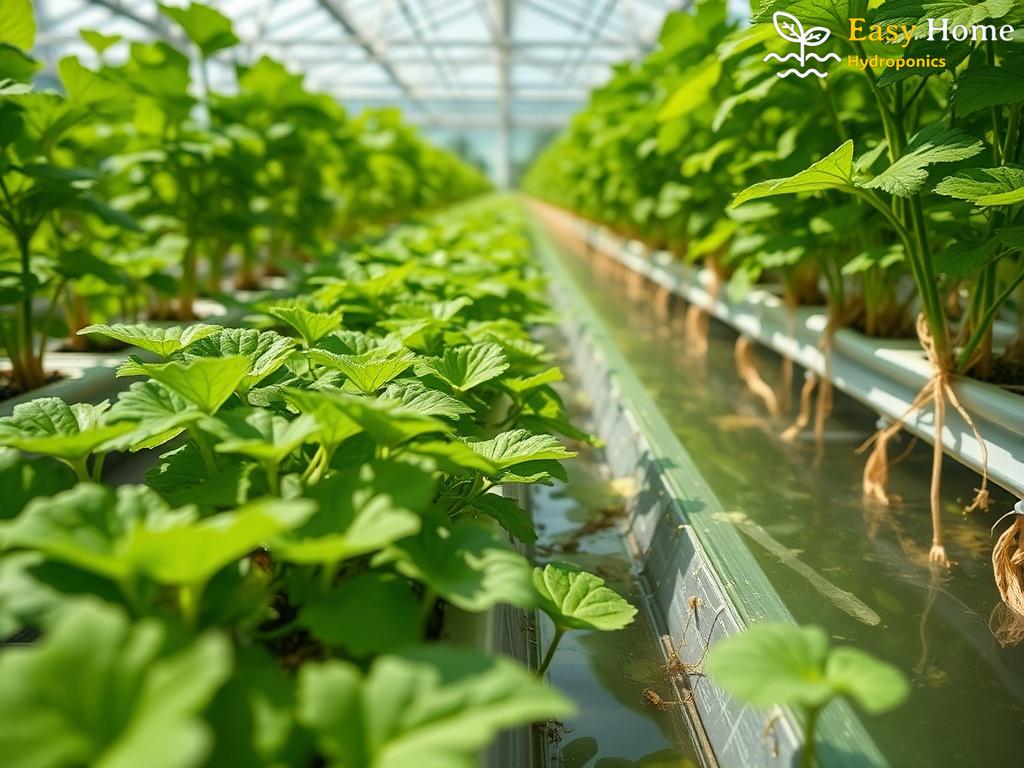The Hydroponic Revolution: Growing Ginger Indoors
Why Hydroponics is the Future of Indoor Gardening
Imagine plucking fresh ginger roots straight from your indoor garden, their spicy aroma wafting through the air. Hydroponics is transforming the way we think about growing plants indoors, and ginger is no exception. This innovative method not only maximizes space but also allows for more control over the growing environment, ensuring a bountiful harvest of this beloved spice.
Setting Up Your Hydroponic Ginger Garden
Before diving into the world of hydroponic ginger cultivation, it’s essential to understand the setup required for optimal growth. Hydroponics involves growing plants in nutrient-rich water instead of soil, which can be a game-changer for ginger, a plant that thrives in warm, humid conditions.
- Choose the Right System: Consider options like Deep Water Culture (DWC) or Nutrient Film Technique (NFT) for growing ginger. DWC is particularly effective as it allows roots to absorb nutrients directly from the water.
- Select the Perfect Container: Ginger needs space to grow. Opt for deep containers to accommodate the root system, which can extend several inches down.
- Provide Adequate Lighting: Ginger thrives in bright, indirect sunlight. Use grow lights if natural light is insufficient.
- Maintain Optimal Temperature and Humidity: Aim for a warm environment between 70°F to 85°F (21°C to 29°C) and humidity levels around 60% to 70%.
The Benefits of Growing Ginger Hydroponically
Why should you consider growing ginger hydroponically? The benefits are numerous and compelling, making it a worthy investment for any indoor gardener. Below are some key advantages:
| Benefit | Description |
|---|---|
| Faster Growth | Hydroponic systems often lead to quicker growth rates due to direct access to nutrients. |
| Space Efficiency | Ginger can be grown in smaller areas compared to traditional gardening methods. |
| Reduced Pest Issues | Soil-less gardening minimizes the risk of soil-borne pests and diseases. |
| Year-Round Harvest | With controlled conditions, you can harvest ginger at any time of the year. |
In conclusion, the hydroponic revolution opens up endless possibilities for indoor gardening enthusiasts. By growing ginger hydroponically, you not only enjoy fresh, spicy roots at your fingertips but also participate in a sustainable gardening practice that benefits both your health and the environment.
Nutritional Benefits of Hydroponic Ginger
When it comes to culinary delights, ginger stands out not only for its distinctive flavor but also for its impressive health benefits. Hydroponically grown ginger, in particular, offers a treasure trove of nutrients, making it a powerhouse addition to your indoor garden. By cultivating ginger in a hydroponic system, you can ensure that every root is packed with vitality and flavor, thanks to the controlled environment that optimizes its growth.
Rich in Antioxidants: One of the standout features of ginger is its high antioxidant content. These compounds play a critical role in fighting oxidative stress in the body, which can lead to chronic diseases. Hydroponic ginger, nurtured in nutrient-rich water, tends to have enhanced levels of these antioxidants, providing your body with a better defense against free radicals. This is particularly beneficial for those looking to boost their immune system and overall health.
Anti-Inflammatory Properties: Ginger is renowned for its anti-inflammatory benefits, making it a natural remedy for ailments such as arthritis and muscle soreness. The hydroponic method, which allows for precise nutrient management, means that ginger can develop a higher concentration of gingerol, the active compound responsible for its anti-inflammatory effects. Thus, cultivating ginger indoors not only caters to your culinary needs but also supports your body’s resilience against inflammation.
Digestive Health Benefits: Incorporating hydroponic ginger into your diet can significantly aid digestion. It stimulates saliva, bile, and gastric juices, thereby enhancing the digestive process. With hydroponically grown ginger, you can enjoy fresh, potent roots that stimulate your digestive system effectively, promoting gut health and alleviating common digestive issues like bloating and nausea. This makes ginger a quintessential ingredient for teas and culinary dishes alike.
In summary, the nutritional benefits of hydroponic ginger extend far beyond its culinary appeal. By growing this aromatic spice indoors, you harness its full potential, enriching your diet with antioxidants, anti-inflammatory properties, and digestive health benefits. Whether you’re a seasoned gardener or a newcomer, cultivating hydroponic ginger is a fulfilling endeavor that promotes wellness and enhances your culinary experiences.
Essential Tips for Hydroponic Ginger Cultivation
Growing hydroponic ginger can be a rewarding experience, but it requires a bit of knowledge and careful planning to ensure success. This section provides essential tips that will guide you through the intricacies of cultivating ginger in a hydroponic system. With the right approach, you can enjoy a thriving indoor garden that yields flavorful and nutritious ginger roots.
Mastering the Art of Nutrient Management
The foundation of successful hydroponic ginger cultivation lies in understanding nutrient management. Unlike traditional soil gardening, hydroponics relies entirely on nutrient solutions to nourish your plants. A balanced mixture of macronutrients and micronutrients is crucial for promoting healthy growth. To achieve this, consider investing in a high-quality hydroponic nutrient solution specifically designed for root vegetables. Regularly monitoring the pH level is equally important; ginger prefers a pH range of 5.5 to 6.5. Maintaining this balance ensures that your plants can absorb nutrients effectively, leading to vibrant growth and robust flavor.
Creating the Ideal Growing Environment
Ginger flourishes in warm, humid conditions, making the environment you create vital for its success. A temperature range of 70°F to 85°F (21°C to 29°C) is optimal, so be prepared to adjust your indoor climate accordingly. Utilizing a hygrometer can help you monitor humidity levels, which should ideally be maintained between 60% and 70%. You can enhance humidity through misting or using a humidifier. Moreover, proper air circulation is essential to prevent mold and fungal growth. Incorporating fans into your setup can help ensure that your ginger plants receive the airflow they need to thrive.
Patience and Timing: The Keys to Harvest
One of the most exciting aspects of growing ginger hydroponically is the anticipation of harvest time. Ginger typically takes around 8 to 10 months to mature fully, so patience is crucial. During this time, you should regularly check the root development by gently lifting a container to examine the growth without disturbing the entire plant. To determine the best time to harvest, look for a change in foliage color and a slight drooping of the leaves, indicating the roots have reached their peak flavor and potency. Carefully harvest to avoid damaging the delicate roots, and enjoy the fruits of your labor in your favorite dishes!
Harvesting and Using Your Indoor Ginger
After months of nurturing your hydroponic ginger, the moment of harvest is not just rewarding; it’s exhilarating! The anticipation builds as you envision the culinary delights you can create with your fresh, home-grown ginger. Knowing when and how to harvest is key to maximizing both flavor and health benefits, ensuring your indoor garden flourishes while providing you with the tastiest roots possible.
Timing Your Harvest: The Right Moment
Understanding the optimal time for harvesting your ginger is crucial. Ginger requires patience, as it typically takes between 8 to 10 months to reach maturity. However, you can start enjoying the benefits of your plants even before they are fully mature. Here’s what to look for:
- Foliage Changes: As the leaves begin to change color, turning from vibrant green to a more subdued hue, it signals that your ginger is nearing harvest time.
- Leaf Drooping: When the leaves start to droop slightly, it indicates that the roots have developed sufficient flavor and strength.
- Root Size: If you’re eager to sample your ginger, gently lift the container to inspect the root size. Small roots can be harvested early, while larger ones offer a more potent flavor profile.
Harvesting Techniques: Gentle Yet Effective
When it’s time to harvest, approach the task with care to avoid damaging the delicate roots. Here are some techniques that can ensure a successful harvest:
- Loosening the Roots: Use your hands or a trowel to gently loosen the root ball from the growing medium, ensuring you don’t tear the roots.
- Cutting Carefully: If you prefer to cut the ginger from the plant, use a sharp knife and make clean cuts to minimize injury to the plant.
- Storage: After harvesting, wash the ginger roots to remove any growing medium, then dry them thoroughly. You can store ginger in a cool, dark place or refrigerate it to preserve freshness.
Culinary Adventures: Using Your Hydroponic Ginger
With your fresh ginger roots ready to use, the culinary possibilities are endless! Whether you’re adding a spicy kick to your dishes or brewing soothing teas, hydroponic ginger elevates your cooking experience. Here are some delightful ways to incorporate your harvest:
- Ginger Tea: Slice fresh ginger and steep it in hot water for a refreshing and health-boosting beverage.
- Flavor Enhancer: Grate or mince ginger to add to stir-fries, soups, or marinades for a burst of flavor.
- Baking: Incorporate ginger into baked goods like cookies and breads for a delightful spice.
In summary, harvesting and using your hydroponic ginger is not only a gratifying experience but also an opportunity to enhance your culinary repertoire. With proper timing and care during the harvest, along with creative uses in the kitchen, your indoor garden can continue to thrive and bring joy to your meals.
Common Challenges in Hydroponic Ginger Growing
While the prospect of growing hydroponic ginger in your indoor garden is tantalizing, it’s essential to acknowledge that certain challenges can arise along the way. Understanding these obstacles is critical for any indoor gardener aiming to maximize their harvest of this aromatic spice. By being aware of potential pitfalls, you can cultivate a thriving environment for your ginger and enjoy its flavorful roots for culinary delights.
Environmental Factors and Their Impact
One of the most significant challenges in hydroponic ginger cultivation is maintaining the right environmental conditions. Ginger thrives in warm, humid climates, and replicating these conditions indoors can be tricky. For optimal growth, the temperature should be maintained between 70°F to 85°F (21°C to 29°C). However, fluctuations in temperature can stress your plants, leading to stunted growth or even root rot. Additionally, achieving the necessary humidity levels, ideally around 60% to 70%, requires careful monitoring and adjustments. Investing in a reliable hygrometer can help track humidity, while using humidifiers or misting can create the perfect atmosphere for your ginger.
Pest Management and Preventative Measures
Even in a hydroponic setup, pests can pose a threat to your ginger plants. Common pests include aphids, spider mites, and whiteflies, which can wreak havoc on your indoor garden. To combat these issues, it’s vital to implement preventative measures early on. Regularly checking your plants for signs of infestation can help catch any problems before they escalate. Using natural pest deterrents, such as neem oil or insecticidal soap, can be effective without damaging your plants or the environment. Furthermore, ensuring proper air circulation can help deter pests from taking hold, as stagnant air can create an inviting environment for unwanted visitors.
Nutrient Management and Its Importance
Another challenge that many indoor gardeners face is maintaining a balanced nutrient solution for their hydroponic ginger. Unlike soil, which naturally contains a variety of nutrients, hydroponics relies on the careful management of nutrient solutions to provide all the necessary elements for growth. It’s crucial to monitor the pH levels, which should ideally be between 5.5 to 6.5, as this will directly affect nutrient absorption. Regularly testing and adjusting your nutrient solution can prevent deficiencies or toxicities that would otherwise hinder your ginger’s development. Moreover, understanding the specific nutrient needs of ginger at different growth stages can lead to a healthier and more robust harvest.




